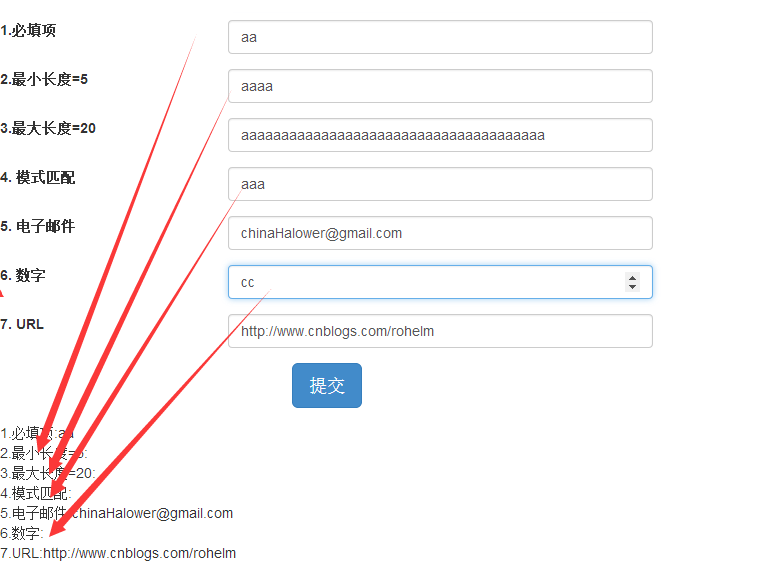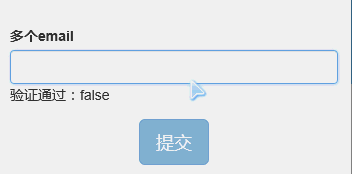
Start learning AngularJS form validation:
Commonly used form validation instructions
1. Verification of required fields
Whether a form input has been filled in, just add the HTML5 required tag on the input field element:
2. Minimum length
To verify whether the text length of the form input is greater than a certain minimum value, use the command ng-minleng= "{number}" on the input field:
3. Maximum length
To verify whether the text length of the form input is less than or equal to a certain maximum value, use the command ng-maxlength="{number}" on the input field:
4. Pattern matching
Use ng-pattern="/PATTERN/" to ensure that the input matches the specified regular expression:
5. Email
To verify whether the input content is an email, just set the input type to email as follows:
Verify whether the input content is a number and set the input type to number:
7. URL
Verify whether the input content is a URL, set the input type to url:
Let’s put these form validations into specific implementations to test them:
<div class="col-md-6">
<form role="form" class="form-horizontal">
<div class="form-group">
<div class="col-md-4">
<label for="name">1.必填项</label>
</div>
<div class="col-md-8">
<input class="form-control" id="name" type="text" required ng-model='user.name' />
</div>
</div>
<div class="form-group">
<div class="col-md-4">
<label for="minlength">2.最小长度=5</label>
</div>
<div class="col-md-8">
<input type="text" id="minlength" ng-minlength="5" ng-model="user.minlength" class="form-control" />
</div>
</div>
<div class="form-group">
<div class="col-md-4">
<label for="minlength">3.最大长度=20</label>
</div>
<div class="col-md-8">
<input type="text" ng-model="user.maxlength" ng-maxlength="20" class="form-control" />
</div>
</div>
<div class="form-group">
<div class="col-md-4">
<label for="minlength">4. 模式匹配</label>
</div>
<div class="col-md-8">
<input type="text" id="minlength" ng-model="user.pattern" ng-pattern="/^[a-zA-Z]*\d$/" class="form-control" />
</div>
</div>
<div class="form-group">
<div class="col-md-4">
<label for="email">5. 电子邮件</label>
</div>
<div class="col-md-8">
<input type="email" id="email" name="email" ng-model="user.email" class="form-control" />
</div>
</div>
<div class="form-group">
<div class="col-md-4">
<label for="age">6. 数字</label>
</div>
<div class="col-md-8">
<input type="number" id="age" name="age" ng-model="user.age" class="form-control" />
</div>
</div>
<div class="form-group">
<div class="col-md-4">
<label for="url"> 7. URL</label>
</div>
<div class="col-md-8">
<input type="url" id="url" name="homepage" ng-model="user.url" class="form-control" />
</div>
</div>
<div class="form-group text-center">
<input class="btn btn-primary btn-lg" type="submit" value="提交" />
</div>
</form>
</div>
<div class="col-md-12">
1.必填项:{{user.name}}<br>
2.最小长度=5:{{user.minlength}}<br>
3.最大长度=20:{{user.maxlength}}<br>
4.模式匹配:{{user.pattern}}<br>
5.电子邮件:{{user.email}}<br>
6.数字:{{user.age}}<br>
7.URL:{{user.url}}<br>
</div>
在测试中我们发现,只有当表达式满足验证,才会实时进行双向绑定。同时我们也发现,效果图如下:

似乎并没有发生什么问题,但是如果我们将其移植到一个队HTML5验证不怎么好的浏览器再来测试一下【本例IE9】,问题来了,某些字段完全没得验证

其实,上面的例子,我们利用了HTML5的验证与ng自有的验证进行了结合,不支持HTML5验证,但ng自由验证运行良好。解决方案很简单,可以使用模式匹配的方式解决这几种情况,也可以自定义验证指令来复写或者重定义验证规则。
屏蔽浏览器对表单的默认验证行为
在表单元素上添加novalidate标记即可,问题是我们怎么知道我们的表单有哪些字段是有效的,那些事非法或者无效的?ng对此也提供了非常棒的解决方案,表单的属性可以在其所属的$scope对象中访问到,而我们又可以访问$scope对象,因此JavaScript可以间接地访问DOM中的表单属性。借助这些属性,我们可以对表单做出实时响应。
可以使用formName.inputFieldName.property的格式访问这些属性。
未修改过的表单
布尔值属性,表示用户是否修改了表单。如果为ture,表示没有修改过;false表示修改过formName.inputFieldName.$pristine;
修改的表单
布尔型属性,当且仅当用户实际已经修改的表单。不管表单是否通过验证:formName.inputFieldName.$dirty
经过验证的表单
布尔型属性,它指示表单是否通过验证。如果表单当前通过验证,他将为true:formName.inputFieldName.$valid
未通过验证的表单:formName.inputFieldName.$invalid
最后两个属性在用于DOM元素的显示或隐藏时是特别有用的。同时,如果要设置特定的class时,他们也非常有用的。
错误
这是AngularJS提供的另外一个非常有用的属性:$error对象。它包含当前表单的所有验证内容,以及它们是否合法的信息。用下面的语法访问这个属性
formName.inputfieldName.$error
如果验证失败,这个属性的值为true;如果值为false,说明输入字段的值通过了验证。
下面我们对这些验证指令进行测试:
<!DOCTYPE html>
<html ng-app="myTest">
<head>
<meta name="viewport" content="width=device-width" />
<title>Index</title>
<link href="~/Content/css/bootstrap.min.css" rel="stylesheet" />
<script src="~/Javascript/angular.min.js"> </script>
<style type="text/css">
body { padding-top: 30px; }
</style>
</head>
<body ng-Controller="MyController">
<div class="col-md-6">
<form role="form" name="myForm" ng-submit="submitForm(myForm.$valid)" class="form-horizontal" novalidate>
<div class="form-group has-feedback">
<div class="col-md-4">
<label for="name">1.必填项</label>
</div>
<div class="col-md-8">
<input class="form-control" id="name" name="name" type="text" required ng-model='user.name' />
<span class="glyphicon glyphicon-ok form-control-feedback"
ng-show="myForm.name.$dirty && myForm.name.$valid"></span>
</div>
</div>
<div class="form-group has-feedback">
<div class="col-md-4">
<label for="minlength">2.最小长度=5</label>
</div>
<div class="col-md-8">
<input type="text" id="minlength" name="minlength" ng-minlength="5" ng-model="user.minlength" class="form-control" />
<span class="glyphicon glyphicon-ok form-control-feedback"
ng-show="myForm.minlength.$dirty && myForm.minlength.$valid"></span>
</div>
</div>
<div class="form-group has-feedback">
<div class="col-md-4">
<label for="maxlength">3.最大长度=20</label>
</div>
<div class="col-md-8">
<input type="text" id="maxlength" name="maxlength" ng-model="user.maxlength" ng-maxlength="20" class="form-control" />
<span class="glyphicon glyphicon-ok form-control-feedback"
ng-show="myForm.maxlength.$dirty && myForm.maxlength.$valid"></span>
</div>
</div>
<div class="form-group has-feedback">
<div class="col-md-4">
<label for="pattern">4. 模式匹配</label>
</div>
<div class="col-md-8">
<input type="text" id="pattern" name="pattern" ng-model="user.pattern" ng-pattern="/^[a-zA-Z]*\d$/" class="form-control" />
<span class="glyphicon glyphicon-ok form-control-feedback"
ng-show="myForm.pattern.$dirty && myForm.pattern.$valid"></span>
</div>
</div>
<div class="form-group has-feedback">
<div class="col-md-4">
<label for="email">5. 电子邮件</label>
</div>
<div class="col-md-8">
<input type="email" id="email" name="email" ng-model="user.email" class="form-control" />
<span class="glyphicon glyphicon-ok form-control-feedback"
ng-show="myForm.email.$dirty && myForm.email.$valid"></span>
</div>
</div>
<div class="form-group has-feedback">
<div class="col-md-4">
<label for="age">6. 数字</label>
</div>
<div class="col-md-8">
<input type="number" id="age" name="age" ng-model="user.age" class="form-control" />
<span class="glyphicon glyphicon-ok form-control-feedback"
ng-show="myForm.age.$dirty && myForm.age.$valid"></span>
</div>
</div>
<div class="form-group has-feedback">
<div class="col-md-4">
<label for="url"> 7. URL</label>
</div>
<div class="col-md-8">
<input type="url" id="url" name="url" ng-model="user.url" class="form-control" />
<span class="glyphicon glyphicon-ok form-control-feedback"
ng-show="myForm.url.$dirty && myForm.url.$valid"></span>
</div>
</div>
<div class="form-group text-center">
<input class="btn btn-primary btn-lg" ng-disabled="myForm.$invalid" type="submit" value="提交" />
</div>
</form>
</div>
<div class="col-md-12">
1.必填项:{{user.name}}
$pristine 【没修改】:{{myForm.name.$pristine }}
$dirty【修改过】:{{myForm.name.$dirty}}
$invalid【验证失败】:{{myForm.name.$invalid}}
$invalid【验证成功】:{{myForm.name.$valid}}
required:{{myForm.name.$error.required}}
<br>
2.最小长度=5:{{user.minlength}}
$pristine 【没修改】:{{myForm.minlength.$pristine }}
$dirty【修改过】:{{myForm.minlength.$dirty}}
$invalid【验证失败】:{{myForm.minlength.$invalid}}
$invalid【验证成功】:{{myForm.minlength.$valid}}
$error【错误详情】:{{myForm.minlength.$error}} <br>
3.最大长度=20:{{user.maxlength}}
$pristine 【没修改】:{{myForm.maxlength.$pristine }}
$dirty【修改过】:{{myForm.maxlength.$dirty}}
$invalid【验证失败】:{{myForm.maxlength.$invalid}}
$invalid【验证成功】:{{myForm.maxlength.$valid}}
$error【错误详情】:{{myForm.maxlength.$error}} <br>
4.模式匹配:{{user.pattern}}
$pristine 【没修改】:{{myForm.pattern.$pristine }}
$dirty【修改过】:{{myForm.pattern.$dirty}}
$invalid【验证失败】:{{myForm.pattern.$invalid}}
$invalid【验证成功】:{{myForm.pattern.$valid}}
$error【错误详情】:{{myForm.pattern.$error}} <br>
5.电子邮件:{{user.email}}
$pristine 【没修改】:{{myForm.email.$pristine }}
$dirty【修改过】:{{myForm.email.$dirty}}
$invalid【验证失败】:{{myForm.email.$invalid}}
$invalid【验证成功】:{{myForm.email.$valid}}
$error【错误详情】:{{myForm.email.$error}} <br>
6.数字:{{user.age}}
$pristine 【没修改】:{{myForm.age.$pristine }}
$dirty【修改过】:{{myForm.age.$dirty}}
$invalid【验证失败】:{{myForm.age.$invalid}}
$invalid【验证成功】:{{myForm.age.$valid}}
$error【错误详情】:{{myForm.age.$error}} <br>
7.URL:{{user.url}}
$pristine 【没修改】:{{myForm.url.$pristine }}
$dirty【修改过】:{{myForm.url.$dirty}}
$invalid【验证失败】:{{myForm.url.$invalid}}
$invalid【验证成功】:{{myForm.url.$valid}}
$error【错误详情】:{{myForm.url.$error}} <br>
</div>
</body>
</html>
<script type="text/javascript">
angular.module('myTest', [])
.controller('myController', function($scope) {
$scope.submitForm = function(isValid) {
if (!isValid) {
alert('验证失败');
}
};
}
);
</script>
效果如下:

同时,ng针对这几种验证指令,针对性的设置了一些css样式
它们包括:
.ng-valid { }
.ng-invalid { }
.ng-pristine { }
.ng-dirty { }
/* really specific css rules applied by angular */
.ng-invalid-required { }
.ng-invalid-minlength { }
.ng-valid-max-length { }
它们对应着表单输入字段的特定状态。
例如当某个字段中的输入非法时,.ng-invlid类会被添加到这个字段上。 你可以编辑自己喜欢的CSS . 你可以私有定制化这些类来实现特定的场景应用.
但是,默认的验证指令不一定能够,完全满足我们的真实应用场景,ng同样提供的自定义验证指令的功能。
首先我们来看一个简单的例子:
angular.module("myTest", [])
.directive('multipleEmail', [function () {
return {
require: "ngModel",
link: function (scope, element, attr, ngModel) {
if (ngModel) {
var emailsRegexp = /^([a-z0-9!#$%&'*+\/=?^_`{|}~.-]+@[a-z0-9-]+(\.[a-z0-9-]+)*[;;]?)+$/i;
}
var customValidator = function (value) {
var validity = ngModel.$isEmpty(value) || emailsRegexp.test(value);
ngModel.$setValidity("multipleEmail", validity);
return validity ? value : undefined;
};
ngModel.$formatters.push(customValidator);
ngModel.$parsers.push(customValidator);
}
};
}])页面Html部分代码如下:
<form class="form-horizontal" role="form" id="custom_form" name="custom_form" novalidate>
<div class="form-group">
<label class="col-sm-2 control-label">多个email</label>
<div class="col-sm-10">
<input multiple-email name="user_email" ng-model="user.email" required class="form-control" placeholder="自定义验证,多个邮箱地址,以“;”或者“;”分割" />
验证通过:{{custom_form.user_email.$valid}}
</div>
</div>
<div class="form-group text-center">
<input class="btn btn-primary btn-lg" ng-disabled="custom_form.$invalid" type="submit" value="提交" />
</div>
</form>
程式碼非常的簡單,實現的效果如下圖:

這段程式碼很簡單,但涉及了ngModelController的幾個重要的屬性
$viewValue
$viewValue屬性保存更新視圖所需的實際字串。
$modelValue
$modelValue由資料模型持有。 $modelValue和$viewValue可能是不同的,取決於$parser管線是否對其進行了操作。
$parsers
$parsers的值是一個由函數組成的數組,當用戶同控制器進行交互,並且ngModelController中的$setViewValue()方法被調用時,其中的函數在當用戶同控制器進行交互,並且ngModelController中的$setViewValue()方法被調會以流水線的形式被逐一調用。 ngModel從DOM讀取的值會被傳入$parsers中的函數,並依序被其中的解析器處理。這是為了對值進行處理和修飾。
備註:ngModel.$setViewValue()函數用於設定作用域中的視圖值。
ngModel.$set ViewValue()函數可以接受一個參數。
value(字串):value參數是我們想要賦值給ngModel實例的實際值。
這個方法會更新控制器上本地的$viewValue,然後將值傳遞給每一個$parser函數(包含驗證器)。當值被解析,且$parser管線中所有的函數都呼叫完成後,值會被賦給$modelValue屬性,並且傳遞給指令中ng-model屬性所提供的表達式。最後,所有步驟都完成後,$viewChangeListeners中所有的監聽器都會被呼叫。注意,單獨呼叫$setViewValue()不會喚起一個新的digest循環,因此如果想要更新指令,需要在設定$viewValue後手動觸發digest。 $setViewValue()方法適合在自訂指令中監聽自訂事件(例如使用具有回呼函數的jQuery插件),我們會希望在回呼時設定$viewValue並執行digest循環。
$formatters
$formatters的值是一個由函數組成的數組,其中的函數會以流水線的形式在資料模型的值發生變化時被逐一調用。它和$parser管線互不影響,用來對值進行格式化和轉換,以便在綁定了這個值的控制項中顯示。
$viewChangeListeners
$viewChangeListeners的值是一個由函數組成的數組,其中的函數會以流水線的形式在視圖中的值發生變化時被逐一調用。透過$viewChangeListeners,可以在無需使用$watch的情況下實現類似的行為。由於返回值會被忽略,因此這些函數不需要返回值。
$error
$error物件中保存著沒有通過驗證的驗證器名稱以及對應的錯誤訊息。
$pristine
$pristine的值是布林型的,可以告訴我們使用者是否對控制項進行了修改。
$dirty
$dirty的值和$pristine相反,可以告訴我們使用者是否和控制項進行過互動。
$valid
$valid值可以告訴我們目前的控制項是否有錯誤。當有錯誤時值為false,沒有錯誤時值為true。
$invalid
$invalid值可以告訴我們目前控制項中是否存在至少一個錯誤,它的值和$valid相反。
以上就是本文的全部內容,希望對大家實現AngularJS表單驗證有所幫助。




